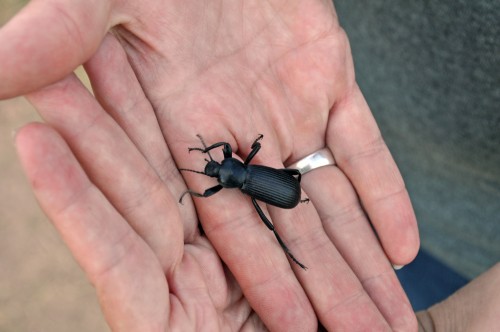As soon as you start looking you’ll notice, they’re everywhere!
by Paige Wiren
The combination of crumbled dry earth and pebbles crunches beneath our feet with each step. Armed with an entomologist’s tools—net, magnifying glass and clear vials—Christy scans the nearby grasses as she relates her introduction to the world of insects. “I played with potato bugs and daddy long-legs with my grandmother, but it wasn’t until a high school biology teacher got me interested that I realized how cool bugs are. And think about it…” Christy begins, which is how we spent the waning hours of a warm summer bug-collecting night in the foothills above the avenues: thinking about the fascinating world of insects.
Christy Bills is the entomology collections manager for the Utah Museum of Natural History and she thinks about insects. A lot. “Did you know, there are more beetle species than mammals, birds, reptiles and fish combined?” Did you know that you can coax a tarantula out of its burrow using piece of grass? And that, Christy told me, we still don’t understand the motivating factors for grasshopper outbreaks? “There are forces unseen that we have yet to discover,” she considers, genuinely awed.
One species Christy did discover in Utah, however, is Pyrrhocoris apterus. “That was cool,” she recounts.
“A friend called me and said, ‘I found this new box elder bug.’ I took it and went through the drawers [at the museum] and there was nothing else like it either there or in the holdings at BYU and USU so I called the state entomologist, which is like saying Michael Jackson—he’s a rock star!—and he confirmed my finding.”
Christy’s ebullient enthusiasm and desire to educate fueled the development of the museum’s Bug Zoo where the public can learn about select live species. “We think every bug is either our friend or our enemy. People don’t realize how beautiful, mysterious and vital insects are to life.” Beautiful? “I think they’re really pretty,” Christy asserts. “They’re definitely more pretty than flowers!”
Strolling along the path Christy stops to observe ants on a stalk of long grass. She picks up a stray chunk of a weathered tree branch and discovers a wood boring beetle. A swift flick of the net bags a carpenter bee.
“The thing about entomology is it’s the most perfect segue into the natural sciences for children. I take every opportunity I can to teach or encourage children to learn about and explore the natural world through insects. I teach a summer field camp for kids and we do no crafts. They get filthy and tired and they love it.”
“Ooooo,” Christy exclaims as she turns over a rock. “That’s cool!”
The stereotype, of course, is that boys are more inclined than girls to be interested in insects. “Girls learn that women are afraid of insects and they feminize that fear. I see it in action when I’m giving presentations, where the mom says ‘Eeeew,’ and then the daughter mimics her and says ‘Eeeew.’ But if I can be alone with a little girl for 30 minutes I can move her from a butterfly to a moth to beetles, and pretty soon she’s holding cockroaches.” 
“People think that all the cool bugs are in the rainforest, but that’s not true.” Christy notes that “there are more bees in the desert than in the rainforest,” and adds that we have a world class bee lab here in Logan. And, Utah is the most northern habitat for one of our two species of tarantula, the most misunderstood of our local arthropods, what Christy calls the “fuzzy teddy bear of the arachnid world.”
“One of my favorite things is when people call and say, ‘I have a bug.’ I like to see how many questions I can ID it in.” What would Christy consider to be a “good find” here in Utah? “Blue carpenter bees, because that would mean you have good pollinators.” Salt Lake Bug Lovers is a facebook group she started for people interested in sharing or learning more about arthropods.
“Collections in museums are collected, but they’re not necessarily studied,” Christy explains as we end our hike, so now that the Bug Zoo is fully developed she is going to “geek out” as she puts it and focus on studying the museum’s 180,000-specimen collection of which some 19th century specimens, Christy reverently notes, “were collected in the horse and buggy days.” One fly in the holdings came from Normandy in 1944. “That fly was collected amidst the turmoil of war. When I thought about that” she says, looking out over the cityscape below us, “it made me cry.”
“I appreciate that I get to be connected to Utah history,” she says thoughtfully, “and I am honored to be a link in the chain of passing on this collection.” §


